|
October 1945 Radio-Craft
 [Table of Contents] [Table of Contents]
Wax nostalgic about and learn from the history of early electronics.
See articles from Radio-Craft,
published 1929 - 1953. All copyrights are hereby acknowledged.
|
By the beginning of 1945 when
most people believed the War was all but won, the national and global attitude began
to shift from a wartime footing back to a commercial and domestic mindset. For the
Axis powers the prospect
was one of shame and contrition, while knowing that unlike if they had been
the victors,
Allied nations would deal harshly only with the leaders of the aggression and
destruction while showing mercy, humanity, and graciousness to the general populations.
In fact we became very good friends with Germany, Italy, and Japan in the years
immediately following their respective unconditional surrenders. China, which Japan
savagely occupied and pillaged, is to this day not overly happy with Japan's continued
existence. Chinese villages still have memorials to American forces who risked their
lives to help defend them from the onslaught. ...but I digress. As the end of hostilities
neared, information began being released by the government about some of the previously
closely guarded secrets of technical developments in the previous half decade -
such as the radar systems covered in this October 1945 issue of Radio-Craft
magazine. See also "Electronic
Navigator."
Radar - Its Many Applications Won War for United Nations
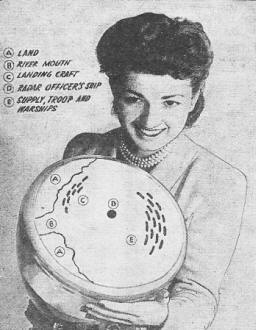
Fig. 1 - This radar tube screen shows a "television" picture
of the surrounding territory. Courtesy General. Electric Co.
By Fred Shunaman
Radar is no longer a (complete) secret. A flood of information on the hitherto
mysterious war-time instrument was released on the eve of Japanese surrender. Many
rumors of near-incredible applications have been proved facts, and applications
undreamed of by the layman are now openly described.
We learn that stories of "Mickey" or the "black box" which were supposed to provide
the pilot of a plane with practically a television view of the country over which
he was flying, were no exaggerations. Rumors of ships being attacked and sunk at
night, in total darkness by means of radar, without ever being sighted visually,
are confirmed. Radar's role as the decisive weapon in the Battles of Britain and
the Atlantic is established.
What was not generally known is that ground radar installations were also used
as super-efficient aerial navigation aids. Used in conjunction with VHF telephonic
communication, they guided pilots to intercept enemy bombers without waste motion
in searching for them, steered them on long runs over enemy territory, and even
signaled the exact moment to drop their bomb loads. Neither was it known that radar
- by means of a special electronic identification device - could distinguish friendly
from hostile aircraft or ships, a feature without which was absolutely necessary
in night attacks.
The underlying principles of radar were described in Radio-Craft's April and
May (1945) issues, (Radar Principles, by R. L. Smith-Rose). These articles detailed
the fundamental type of radar operation, which has been so improved in some cases
as to be almost unrecognizable from descriptions of earlier, simpler apparatus.
An excellent brief outline of radar principles appeared in the bulletin "Radar"
released by the British Information Service, under the head, "How Radar Works,"
extracts from which follow:
***
Radio Waves have many of the properties of sound waves, especially radio waves
of the shorter wave-lengths or higher frequencies. They travel at the same speed
as light - approximately 186,000 miles a second - and can be reflected or "echoed"
from a great variety of objects - as Herz demonstrated as long ago as the end of
the last century.
As radio waves travel at a constant speed, the distance of an object from which
a radio echo, is reflected can be determined from the time the echo takes to return
to the point from which the original wave was transmitted.
For example, let us assume that we have sent out a radio wave from a radar station
and that the echo has come back to the receiver in 1/500th part of a second. We
know that radio waves travel at 186,000 miles a second. Therefore, the distance
out and back from the aircraft must be 186,000 - that is 372 miles. If we halve
that distance for the single journey, we find that the aircraft is 186 miles away
from that station.
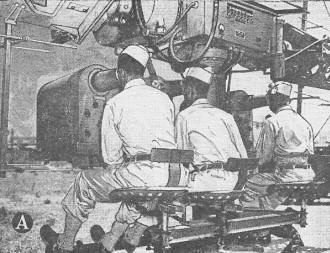
A - Radar crew at work. One calls off the target's altitude while
the other gives its range. The third man plots direction.
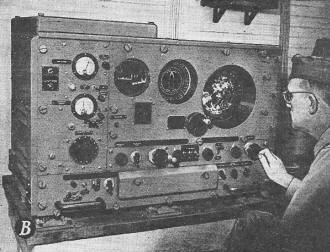
B - A precision radar indicator in use.
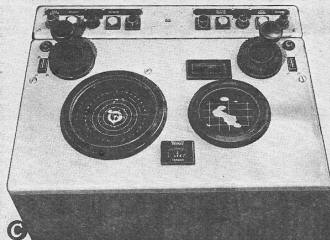
C - Radar repeater, to reproduce information from the main set.
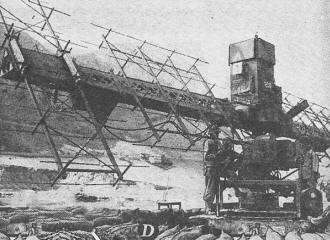
D - A mobile "early warning" mobile radar, photographed to show
the directional "aerial.
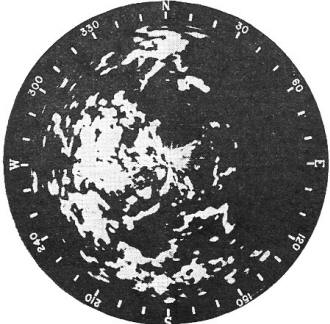
Typical pattern of a radar Cathode-ray screen.
Such short intervals of time are measured by that well-known instrument, the
cathode ray tube, in which a beam of electrons is made to sweep across a fluorescent
screen, in somewhat the same way as a hand sweeps across the clock face.
Just as the second hand of a clock completes its sweep of the face in sixty seconds,
the electron beam can be made to travel across any desired portion of the fluorescent
screen in some predetermined interval of time.
As a simple illustration, let us suppose that the beam is made to travel across
the screen - leaving a straight horizontal line of light - in 1/500th of a second.
This line will represent the time taken for a radio wave to travel 186 miles
out and back. So we can write "0 miles" at the beginning of the line and "186 miles"
at the end. As the waves travel at a constant speed, we can subdivide the whole
line into a scale of miles.
In sending out our radio waves we must be careful to keep them in very small
bursts or "pulses" - not lasting more than a few millionths of a second. The reason
for this is that, otherwise, they would "drown" the returning echo.
(If we want to get an ordinary sound echo we give a short, sharp cry so that
we can hear the echo when it comes back. If we keep up a long yell we shall not
be able to hear the echo. The same principle applies to our radar "shouts" or "pulses".)
The returning radio echo is picked up by highly sensitive receivers and made
momentarily to deflect or dip the electron beam as it sweeps across the fluorescent
screen. This makes a V-shaped depression or "blip" in the line at a point representing
the time taken for the echo to return.
We have already marked off a scale of miles above the line of light, so by reading
the number of miles opposite the "blip" we can tell instantly how far the aircraft
is away.
Of course the process is continuous. Many pulses are being transmitted every
second - with sufficient interval between each to allow the echo to return from
the greatest distance the instrument is designed to measure. The electron beam is
also sweeping up and down the line many times a second and is being deflected by
a constant succession of returning echoes.
All this happens too rapidly for the human eye to see anything but a steady,
glowing line of light with a blip in it. If the aircraft is approaching, the blip
will slowly move in the direction of "0 miles." If it is going away it will move
toward "186 miles." In this way the aircraft's movements can be watched continuously.
***
In the older types of radar, which used fixed antennas, special techniques were
necessary to determine the direction and altitude of approaching aircraft. Modern
"searchlight" equipment uses a rotatable aerial which is turned to the horizontal
and vertical angle at which strongest signals are received, thus determining direction
and altitude angle automatically.
Use of "television technique" marked a great step forward in the versatility
of this new instrument. The use of the very high frequency technique for the detection
of low-flying aircraft had made it practicable to mount the whole aerial system
(now smaller because of the shorter wavelength) on a turntable and to concentrate
the energy into a beam rather like a widely dispersed searchlight. This beam could
sweep the horizon if necessary through the whole 360 degrees, and by suitable devices
on the cathode ray tube line the display could be made to rotate in synchronism.
If the signal returned from an aircraft were made to brighten the line instead of
deflecting it, the position of any aircraft encountered by the beam could be shown
in plan in a bright spot on the circular face of the tube which could then have
a map of the surrounding terrain superimposed on it. This technique is known as
P.P.I. (Plan Position Indicators). See Fig. 1. Moreover, by other almost fantastic
developments, it became possible to project optically the map, aircraft indications
and handwritten plots all together on a translucent screen. The dream of many commanders
is realized in this - the power to sit in a room at headquarters and see all the
movements of hostile and friendly aircraft displayed before them on a map.
Ground-Controlled Fighters
Radar alone made it possible for the pitifully inadequate RAF to meet the hordes
of German raiders and turn them back. One of its earlier special applications was
the so-called GCI (ground-controlled interception). A controller at a fixed installation
watched movements of friend and foe on the screen of a Plan Position Indicator,
sending special instructions called "vectors" to the plane under his control. A
VHF communications system which employed a shorter wave-length than any before used
was all important feature in GCI.
The ground controller was able to note the relative positions of the enemy plane
or planes and that of the planes under his control. By means of the "vector" directions,
his planes could then be maneuvered directly toward the enemy. The pilots, informed
when and where to expect the enemy, had a great advantage over him - so great an
advantage that the small RAF was able not only to turn back vastly superior forces
of raiders but to shoot down what to the Germans seemed to be altogether disproportionate
numbers of them.
Two months of uniformly high losses discouraged the Nazi day raiders and they
turned to night bombing. Hitherto the GCI had simply brought the defending planes
into the path of the oncoming raiders, then left them to the exercise of their own
vision and judgment. In night fighting, the controller would pick out a particular
Nazi plane as target and bring his controlled craft up to the point where the pilot
could just see the enemy as a dark mass ahead. The British fighter could usually
then finish off his adversary before being himself sighted.
A still later development was the smaller AI, or Aircraft Interceptor, a short-range
radar which is carried in the plane. The fighter receives "vectors" from his ground-control
station till within AI range of the enemy, and is then directed to "flash his instrument"
and proceed on his own. An ingenious adaption permitted the pilot to see the image
of the opposing fighter reflected on his windshield. As he approached, the enemy
image became broader - "grew wings." By centering the image dead ahead, the flyer
could approach till the actual plane was seen, superimposed on its own image. Again
the advantage of knowing just where the enemy would appear gave the defending plane
an immense advantage in the darkness, and the luckless Nazi's first warning of the
presence of fighters might be a fatal burst of fire.
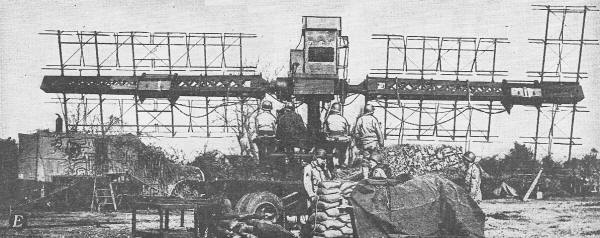
E - Clear picture of a mobile radar. This set-up was able to
pick up Nazi aircraft invisible through overcast, to be picked off by guns just
outside the picture.
Picture credits - A, D, and E - Signal Corps photos of Western
Electric radar apparatus. B, C, and Center - Raytheon Manufacturing Co.
A further refinement of GCI enabled operators in England to guide individual
bombers to enemy positions in cross-Channel occupied territory, leading them exactly
to the bombing point, then signaling for the bombs to be dropped. This was one of
the methods by which the big guns on the invasion coast were destroyed before D-day.
Mine laying operations by airplane were carried on with greatest accuracy by the
use of radar. The planes were piloted by a ground-controller with the aid of a Plan
Position Indicator and instructed as to the exact point to drop each mine.
Higher Frequencies
Further improvement of the instrument came through the use of higher and higher
frequencies. During the Battle of Britain, 200-megacycle waves were considered extremely
good. Even at these frequencies, low-flying aircraft could come in without detection,
losing themselves in the mass of reflections from hills, tall buildings and other
landscape features. A shorter wave length for the radar waves would mean greater
relative size for the antenna, there-by permitting better beaming and clearer definition.
Where greater definition is not absolutely essential, small aerials may be used,
making radar more practical for aircraft. Present-day radar is based on centimeter
waves - of just what length cannot even yet be revealed. The microwave radar was
a step forward almost comparable to Plan Position Indicator.
With the new aircraft apparatus further, developments became possible. Extremely
high-definition Plan Position Indicators were installed in "pathfinder" planes,
which led squadrons of bombers over enemy targets in night raids, or in daytime
expeditions when visual bombing was all but impossible because of the continuous
bad winter weather over northern Europe. One "pathfinder" plane equipped with radar
led a formation of bombers over the target. The radar operator, viewing the scene
below on his cathode-ray screen, dropped flares or colored-smoke bombs to mark the
spot. Then the bombers could come in for the kill. This device was the "Mickey"
or "gen box" concerning which rumors appeared in the press a few months ago.
Radar Goes to Sea
Even more important to the United States was the use of radar for naval offense
and the defense of merchant shipping. In early 1942 German submarines on both sides
of the Atlantic created such havoc with merchant shipping as to leave the issue
of the Battle of the Atlantic in doubt. Supersonic methods of detecting submarines,
though rapidly improved, were unable to curb the destruction.
The first step to combat the menace was installation of radar detection equipment
on airplanes. Submarines have to surface to charge their batteries. Surfaced at
night or lying awash in the daytime with engines off, they were reasonably secure
from sonic and supersonic detection devices. Radar soon put an end to this security.
Planes appeared from nowhere, dropping bombs and depth charges. The number of U-boat
sinkings took a jump that challenged the attention of Nazi technical specialists.
Submarines were fitted with an anti-radar device - a receiver which picked up the
signals sent out by the radar transmitter, giving the sub warning in time to permit
it to submerge and get going before the plane arrived.
Ironically, the Nazis "solved" the plane radar problem just as the Navy was swinging
from 200-mc radar to much higher frequencies. Depending on their radar defense receivers,
submarines surfaced and were blown out of the water. Suspecting everything but radar,
they tried various expedients, including the sending out of two scientific expeditions,
by submarine, equipped with instruments to detect almost any type of radiation.
Neither of these investigating parties lasted two weeks, and finally the Germans
decided that if subs were to survive, they must stay beneath the surface. A breathing
tube (euphonically referred to as a "Schnorkel") permitted taking on fresh air to
run Diesels and charge batteries underwater.
By this time radar and the convoy system had made them well-nigh" ineffective.
In convoys, radar-equipped escort vessels were able to detect and destroy the "wolf-packs,"
giving such effective protection that sinkings dropped to one-tenth of one percent:
Not only did radar prevent raids, but solved the old "sitting-duck" problem which
was the chief cause of losses in earlier convoys. Ships forced to drop out of the
convoy, or which strayed away from it some dark night, were sure victims of the
U-boats. By daylight, when the convoy could be checked, it was too late to do anything
about it.
As soon as escort vessels were equipped with radar, the position of all vessels
in the convoy could be known at all times. If a ship were forced to drop out of
convoy on a dark night, an escort could immediately be at its side to guide it back
to safety, or to remain with it and take it to a safe port, should it be impossible
to regain the convoy.
Radar Gun Computers
Further development of radar led to an adaption which could be attached to the
Norden bombsight or to gun computers, thus eliminating the human element in sighting
guns and bombs. Without this, our ships would have been at a loss indeed when attacked
by the Japanese "Kamikaze" bombers. By the time a suicide bomber could be sighted
it would be too late to attempt to aim anti-aircraft guns. With the radar-controlled
gun-sights, fire was directed at the enemy crash-bomber as soon as he came within
range, and in very few instances did he live through it, to reach his objective.
Another important application of radar-directed gunnery was in fire-control on
Naval vessels. Not alone the anti-aircraft guns but the ships' main batteries were
directed by radar. It is known that in more than one case Japanese ships were sunk
often in dark nights, without ever having been visible to the attacking ship. A
special device worked out early in the war by the British and called IFF (Identification,
Friend or Foe) was very important in such actions. This is an electronic counterpart
of the identification marks carried by aircraft, or the flags flown by surface vessels,
registering on the radar instead of visually. Danger of sinking friendly ships was
thus avoided, and battle by radar became a possibility.
Acknowledgement is made to Radar, A Report on Science at War, distributed by
the Office of War Information, and Radar, put out by the British Information Services,
from which most of the information printed here was obtained.
Posted July 29, 2021
|
















